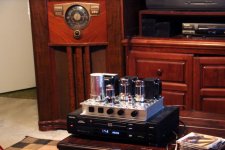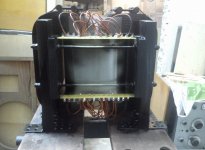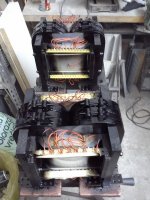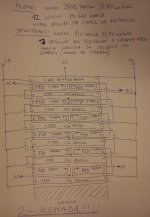Hey-Hey!!!,
I have heard a few big amps. They just don't do the music right. The sound just winds up missing stuff that an amp with smaller outputs can manage. Just in case it turns out I am mistaken, I have a six-pack of GU-81m and four sockets for the Big One waiting in a box...
I suspect that I will learn how to do RF if those tubes ever get lit by me with B+ on the anodes. Nearly half an amp of plate current at 1kV each for a pair across 4k a-a, 300 W of class A audio out. Heh-heh-heh!
cheers,
Douglas
better check floor loading before moving the PS out ov the basement!
I have heard a few big amps. They just don't do the music right. The sound just winds up missing stuff that an amp with smaller outputs can manage. Just in case it turns out I am mistaken, I have a six-pack of GU-81m and four sockets for the Big One waiting in a box...
I suspect that I will learn how to do RF if those tubes ever get lit by me with B+ on the anodes. Nearly half an amp of plate current at 1kV each for a pair across 4k a-a, 300 W of class A audio out. Heh-heh-heh!
cheers,
Douglas
better check floor loading before moving the PS out ov the basement!
I talked with Jack at Electra-Print who knows more about audio transformers than the rest of us all do. He told me that the biggest SE transformer that he would attempt is 100 watts. Unfortunately I couldn't afford a pair, so the "big one" is still on hold. For him the P-P limit was in the 500 watt region, Hammond has a 280 watt version in their catalog. I have seen almost 500 watts go through one from 6 X 6LW6's at 750 volts at 1KHz. Power at 80 Hz was over 350 watts. This was a monster guitar amp built several years ago.
Here is my theory on this. Any transformer has resistive losses, and magnetic losses. The magnetic losses are not all linear. A transformer will be more linear if operated in the middle of its designed power range. When you operate a 100 watt transformer at 1 or 2 watts it will be far less linear than a 10 watt transformer at 1 or 2 watts. In a push pull transformer you are operating on a non linear part of the BH curve at very low powers. This non linear part gets larger with the size of the transformer. In a SE transformer you have hysteresis issues in the middle of the curve, again the larger the transformer, the larger the problem.
I have built several SimpleSE and TubelabSE amps that were identical except for the output transformers. You DEFINITELY miss detail with large transformers. I just finished a SimpleSE (KT88's in triode) with some Transcendar "300B transformers" (low cost transformers from Ebay). I have an identical amplifier that uses Hammond 1628SEA transformers. Today I tested the two amplifiers on two sets of speakers using the same set of tubes. The big Hammond transformers do best on loud music where the amp is cranked up. They also have wall shaking bass on big speakers. However the fine details are lost. Careful listening reveals that those little details that you can pick out with the Transcendars are muffled or lost with the big Hammonds.
Here is a picture of my latest amp. I made the chassis from an idea that I got from one of Morgan Jones books. I used diamond plate for the top and channel aluminum for the sides. The old radio in the background is actually the left channel speaker cabinet. There is a matching one on the other side of the TV cabinet. They contain modern Silver Iris drivers that are 96db efficient. Plenty loud with 5 watts.
I have heard a few big amps. They just don't do the music right. The sound just winds up missing stuff that an amp with smaller outputs can manage.
Here is my theory on this. Any transformer has resistive losses, and magnetic losses. The magnetic losses are not all linear. A transformer will be more linear if operated in the middle of its designed power range. When you operate a 100 watt transformer at 1 or 2 watts it will be far less linear than a 10 watt transformer at 1 or 2 watts. In a push pull transformer you are operating on a non linear part of the BH curve at very low powers. This non linear part gets larger with the size of the transformer. In a SE transformer you have hysteresis issues in the middle of the curve, again the larger the transformer, the larger the problem.
I have built several SimpleSE and TubelabSE amps that were identical except for the output transformers. You DEFINITELY miss detail with large transformers. I just finished a SimpleSE (KT88's in triode) with some Transcendar "300B transformers" (low cost transformers from Ebay). I have an identical amplifier that uses Hammond 1628SEA transformers. Today I tested the two amplifiers on two sets of speakers using the same set of tubes. The big Hammond transformers do best on loud music where the amp is cranked up. They also have wall shaking bass on big speakers. However the fine details are lost. Careful listening reveals that those little details that you can pick out with the Transcendars are muffled or lost with the big Hammonds.
Here is a picture of my latest amp. I made the chassis from an idea that I got from one of Morgan Jones books. I used diamond plate for the top and channel aluminum for the sides. The old radio in the background is actually the left channel speaker cabinet. There is a matching one on the other side of the TV cabinet. They contain modern Silver Iris drivers that are 96db efficient. Plenty loud with 5 watts.
Attachments
tubelab.com said:That first picture is absolutely scary. I am known as "extreme" and there is no way that I would get near that. Are you NUTS! One slip and you are TOAST!
Figure out how many watts you need (or want) and that you can get a transformer for. Then the tube selection will be easier. There was a thread here a while back showing pictures of a 1KW guitar amp using 4 X 813's in push pull. A pair of 833A's can produce over 2.5 KW of audio with forced air cooling and 3KV on the plates.
Well, the fact is that many hobbies are dangerous. Like gun shooting, racing, fireworks, flying, swimming..everyone of them has risks and dangers. Highvoltage electronics is only one in the million hobby which has some dangers to get hurt badly and in worst case, deadly.. Anyway, I have been experienced over 20years so I think I'm not so amateur anymore. that is enough about this, no more offtopic.
I made some plans and it is time to take huge step backwards in my power requirements. I looked some schemas and found one interesting amp. It produces 100W output and uses 807 pair in pushpull. It has also transformer coupling/phase shifting.
I just got two really old amp modules and I planned using them as base for my project. Bad thing is that there is no tubes anymore except preamps (EF40). Originally, it used two EL51 pendodes in pushpull. These has also transformer phase shifters so I want to rebuilt these keepeng in mind its originality as much as possible. Here is picture:
amps
(I just plugged some tubes there so they look better).
Why would you ever need 7200W of audio power?
Definitely won't be an amplifier for the living room..nevertheless can be used for a live concert !
Actually is not the need for such amplifier but the challenge of building such a huge power amplifier.
By the way, the tube datasheet gives the option of 3000W output.
So, I decided to build this amplifier, I have had all the components handy and is almost ready as soon as I install the output transformer.
Pictures of the amplifier,
An externally hosted image should be here but it was not working when we last tested it.
An externally hosted image should be here but it was not working when we last tested it.
Last edited:
Why a Tetrode ?? Why not a inexpensive Triode as GM70??
If Tetrode is a personal preference the GMI-11 looks impressive and inexpensive:
(Seems it starting work at 1200V B+)
QRO-Parts.com
Even more cheap here:
''GSTube.com''. Tubes, sockets etc. Search result for <u>gmi11</u>

If Tetrode is a personal preference the GMI-11 looks impressive and inexpensive:
(Seems it starting work at 1200V B+)
QRO-Parts.com
Even more cheap here:
''GSTube.com''. Tubes, sockets etc. Search result for <u>gmi11</u>

re:Hammond - IIRC, the 1600 series has some HF rolloff within the audible range - can the detail be forced back by small cathode bypass resistor EQ somewhere? - or is it gone forever? I measured the pp-1600 series (1650T/R) and those had weird resonances partly from the way the extra winding is paralleled. I've got some custom Pacific M6 1K p-p transformers rated 280W but only down to 40 from a guitar project which never got started.
I hope those pieces of wood on those transformers aren't pine. They shouldn't be wood on a high voltage transformer at all to be honest. Those pieces should be phenolic. Wood absorbs moisture and slowly burns.
Other then that there quite impressive beasts you have there. Do you have a good Chiropractor, lol.
Other then that there quite impressive beasts you have there. Do you have a good Chiropractor, lol.
Hey Davorin, did you wind those yourself? I have several C-cores that sort of size and larger. One set is to be used for a twin floating output bench supply for some investigation into large high voltage circlotrons. The others I have thought of using as massive output transformers. I would be very glad if you could post your design and performance measurements? Also would it not have been better to fill the window with copper for lower losses than plywood? What size are the cores? If they are the same size as some of the ones I have then I have stainless mounting frames and Paxolin insulators to suit.
Cheers
Matt.
Cheers
Matt.
Hey Davorin, did you wind those yourself? I have several C-cores that sort of size and larger. One set is to be used for a twin floating output bench supply for some investigation into large high voltage circlotrons. The others I have thought of using as massive output transformers. I would be very glad if you could post your design and performance measurements? Also would it not have been better to fill the window with copper for lower losses than plywood? What size are the cores? If they are the same size as some of the ones I have then I have stainless mounting frames and Paxolin insulators to suit.
Cheers
Matt.
Yes, I wound those transformers at my home. I use double complet (4x"C") of CU-132B (DIN norm) high-oriented type of core. Here is my manufacturing sheet and scheme connecting section (Cratian, not English, sorry!). Wooden pieces are oak plywood and beechwood dried, varnished with transformer lacquers than dried and "baked". I tested transformers with high voltage tester (5kV) and all measured data will post later.
Attachments
- Status
- This old topic is closed. If you want to reopen this topic, contact a moderator using the "Report Post" button.
- Home
- Amplifiers
- Tubes / Valves
- BIG tube amplifier, two qbl5/3500 tubes



